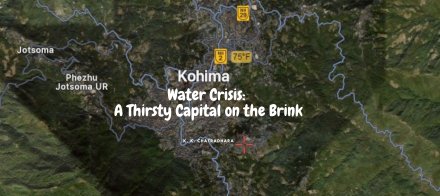 |
Years back, a section of the Uipo community, also known as the Khoibu, one of the minor indigenous ethnic groups of Manipur, decided to move closer to the National Highway 39. They were hoping that they would be able to avail better access to economic opportunities and education for their children in the new place. Over the years, more families came to settle along the highway at Khangshim in the Machi Sub-division of the Chandel District. It was unknown to them that they would be facing multiple crises, including a severe water problem here.
Khangshim village was established in 1972, and two years later, it was formally recognised as a census village. According to the 2011 Census, the Khangshim village has a population of 579 people with 107 households. The current population of the village is estimated to be around 2,000; the majority of them belong to the Uipo (Khoibu) community. In the past decade, several Uipo villages from the uplands have shifted to Khangshim in search of better economic prospects and for children’s education. Now, almost 50 per cent of the whole Uipo population is said to be staying in the Khangshim village. All of them are from the Chandel district. However, there are some Uipo settlements in other districts too, including in the Imphal valley.
Uipo people are a small, threatened indigenous community, and their tiny population has been a great concern, including their eroding culture and language due to mixed marriages and growing intercourse with its affinal sub-tribes. There is a village authority that looks after the affairs of the village. Until recently, the village was headed by a hereditary Uipo chief, but now the village authority has a village chairman.
Until 2008), villagers often sought help from the Assam Rifles, which allowed them to take water from its camp, which was near the village. They used to carry water on their bicycles. But those who live near the roadside could only access the water.
The Weaker Section’s Development Council (WSDC), an NGO working for the welfare of the village, stepped in to address the water issue. The organisation got in touch with the Tata Trusts, a funding agency, and applied for a project to build a few solar pump-attached deep wells. An expert committee came to discuss the project and reviewed the work plans with the villagers. New wells were drilled to a depth of 150 metres in three Uipo villages of Khangshim, Khoibu and Biyang. Solar pumps were installed in these newly dug wells. Everything was fine until the water turned saline some months later. Experts were called upon, and when the water sample was tested, it turned out that the place was a natural salt spring, locally called thumkhong. So, the water from the wells could not be used for drinking purposes.
According to the project guidelines, each solar water pump has to be managed by a water user group where members have to pay a fee. It was also observed that even though the water was available in the well, there were still many who did not have access to water due to their inability to pay or they lived far away from these solar well pumps. Those who have no access, they either dig private wells or buy water. Some families rely on their wealthier relatives who can pay and get some water from them. During the dry season, the well water is not enough, and people have to buy water. Many families buy drinking water from nearby water suppliers of Kakching or Thoubal. They are private operators who buy water from the government supply centres or collect directly from rivers and then sell it in water tankers of 1,500 litres to 12,000 litres. Villagers said they had to pay Rs.1,300 for 12,000 litres of water. Most of the villagers could not afford to buy. This system of buying water exists across Manipur. Reasons, not known! Residents do not question the government for not getting a regular supply of water.
In extreme water scarcity, when wells dry up, almost everyone buys water for drinking purposes. Left with no choice, the villagers take bath with salty water. During the rainy seasons, water is harvested and stored for use. The water level in the wells also rises rapidly during the rainy season.
A Rajasthan-based company, GR Infra-project Limited (GRIL) has clinched the deal for implementing the road project. Subsequently, it has roped in a local firm to initiate the work, which requires setting up a plant site to install specialised heavy machinery used for modern road construction like stone crushers, asphalt mixing plant, road roller machines, excavators, truck cranes and JCBs.
Villagers were unaware of the project until the local contractor decided to set up the plant complex and the labour camp close to the Khangshim village. They were also apprehensive of the impact of the construction activities on the small Uipo/ Khoibu community and the environment but didn’t know how to respond to the situation. The local contractor also didn’t inform the village authority about the proposed road-building works.
The village council led by the hereditary chief of the Uipo/ Khoibu community, and the elders wrote to the ADB stating their concerns and opposition to the proposed plant complex near the village without seeking their consent. In response to the complaint letter, the ADB had sent a fact-finding team from its Manila office to ascertain the veracity of the case. After the visit, the team admitted various lapses and violations of the ADB project agreement and guidelines by the local contractor.
Meanwhile, the village council chief and the small and marginal community elders were pressured by a powerful armed group to withdraw the complaint letter. The chief succumbed to the pressure under duress and wrote to the bank authority informing the withdrawal of the said complaint letter. The case was closed after that but works resumed amidst simmering tension in the village.
Subsequently, the Khoibu chief was also forced to step down, and in his place, a chairman was appointed, setting a new process in the village’s governance.
Even as the ADB, the funding agency of the Asian Highway project, claims to have committed to observing strict standards in its environment management plan (EMP), it remains to be seen how it is followed at the local level. As per the EMP guidelines, no complex site and labour camp can be set up within a distance of 1.5 km from any human habitation. However, the villagers said that the proposed site of the main camp was very close to the Khangshim village. The village authority has been bypassed in the process of land acquisition and selection of the main plant complex and labour camps site. With the change of new authority in the village council and its apparent role of a mere onlooker, the Uipo people are now smarting under the insecurity of life and livelihood, especially agriculture.
The signs are already showing; villagers complained of discharges of effluents from the plant complex and the labour camps, polluting water and agricultural fields. One of the small streams used by the villagers is now unfit for human consumption.
The waterways from the plant site and wastewater from labour camps flow into the farmland, surface, and underground water source of the village. This contamination leads to more stress to the already tricky water situation and long-term consequences on the already threatened Uipo people.
Geolocation is 24.47330731756084, 94.03188669725098


